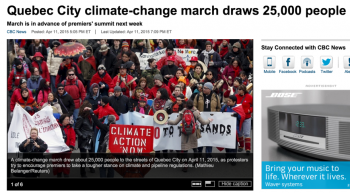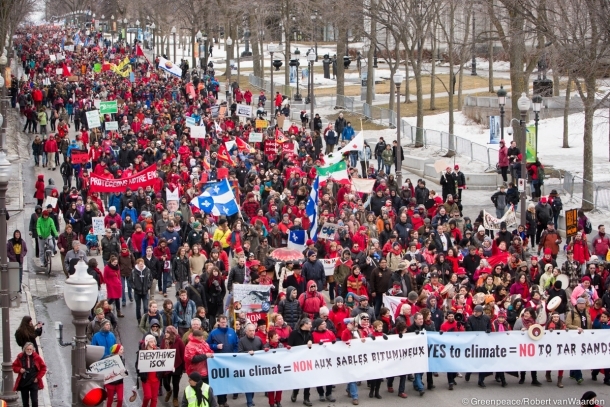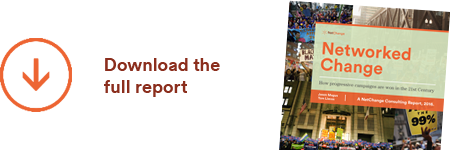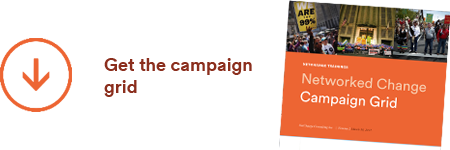After years of complaining pointing to the limitations in how progressives move our issues forward in a 21st century media environment, last weekend I had the great luck of being part of a real breakthrough moment.
The Act on Climate March mobilized 25,000 people to the streets of Quebec City, three days before the Premier of Quebec’s provincial climate summit. By bringing together the best of modern organizing, communications, and digital campaigning we were able to elevate our issue, change the conversation around it, and frame it in a way that boxed our opponents in, all while achieving breakthrough success in traditional and online media.
It was a huge success, and, I believe, set a new high bar for campaign integration. Here’s how I saw it all come together from my role as campaign advisor.
First for inspiration, check out what 25,000 beautiful people marching through Canada’s oldest city looked like:
We started with a smart target

Inspired by the wildly successful People’s Climate March last fall, when the idea was first floated to organize around this climate summit, deep in the environmentally and protest minded province of Quebec, we jumped in with both feet.
But we were realistic about what it would take to influence the meeting, and rather than inside lobbying, reports, media work, or stunts there was an appetite for a mass mobilization.
Doing a rally around a real meeting of decision makers who could conceivably do something we demanded gave the media, and our supporters, a believable theory of change. It also created relevance: Canada’s newspaper of record wrote about us as part of their political analysis three times before we even marched!
Hired skilled people as dedicated staff
The march coordinator is one of the best people I’ve worked with, who worked 20 hour days with grace and intelligence and skill. But importantly, she was hired ONLY to work on this March, with no other side jobs. My digital team then hired an online campaigner inside Quebec, to work on only this. This was the key.
I’ve done too many actions where we rely on slivers of existing partner’s staff time. Staff who may or may not be appropriately skilled for the work we’re needing to be done, and may or may not be effective or top performers. And even if they are, they’re usually split in twenty different directions, overworked and distracted, so you never really know.
In this case we identified the key roles needed to achieve our goals, analyzed the gaps in the network, and filled them in with specialized people able to focus on what matters most. Sure we got lucky, but that structure made all the difference in the world.
Brought digital innovation to good old fashioned organizing
When we first started organizing, I was told that while Quebec had a storied history of massive protests (250,000 in Montreal for Earth Day 2012, 100,000 students protesting austerity three weeks ago, etc) and NGO staff who know how to pivot from policy work into organizing, they weren’t as advanced at digital amplification.
So we created a digital-first strategy, with a fierce focus and clear goals that everyone could understand, and had it validated by the digital team behind the People’s Climate March. We embedded a digital campaigner to work right next to the main coordinator, built up designer capacity, protected a strong digital budget, engaged partners, and encouraged experimentation and nimbleness to come from all directions.
The end result: from a standing start, over 12,000 RSVP’s online, 12,000 ongoing social media followers, well over 100,000 views of march videos, and a “reach” from all related content well into the millions.
Integrated traditional with digital

I’ve been a part of (and partly responsible for) pretty weak integration between traditional PR work and digital, and sometimes even working cross purposes on messaging. This time we integrated from the start.
With the traditional media people working up and us digital folks the middle, we did a pincer move that forced the coalition to find a message that was politically potent, culturally resonant, and simple enough to repeat.
And they did, almost universally across all channels: in signs, press releases, and with spokespeople. As I landed in Quebec City someone forwarded me a national newswire story with literally our only key message, spoken by a member of the coalition, in the exact way we’d planed it (acting on climate ≠ tar sands pipelines). That quote led the article and the story went national. The battle was won before we’d even marched!
Created a centerpoint for the movement to organize around
Like any good network we had traditional NGO’s, grassroots groups, First Nations, and unions large and small working together, mostly seamlessly. Some did a little and some a lot, very little risk or investment was required by any one group, and it all added up to something much bigger than any one could do alone.
Many groups then played to their strengths, using the march as a focal point to launch their best work. In the days before the march, one partner released a national poll on climate attitudes, that connected to the march and became a national story. That same week two other partners highlighted how climate action from two provinces (oil sands producers) would completely wipe out all the efforts of more progressive provinces. It again mentioned the march, and our key message, and it got big pick up. Win win win.
The #1 critique of progressive communications is that we are too nerdy, too detailed, too creative, too independent, and too undisciplined to get our message into the culture and political landscape. And internally or as networks we don’t collaborate effectively or employ the best that new models of organizing offer.
After last weekend’s march I have to update my story about what movements can do together, because we just set a new high bar for 21st century integration. Let’s keep it this high.










